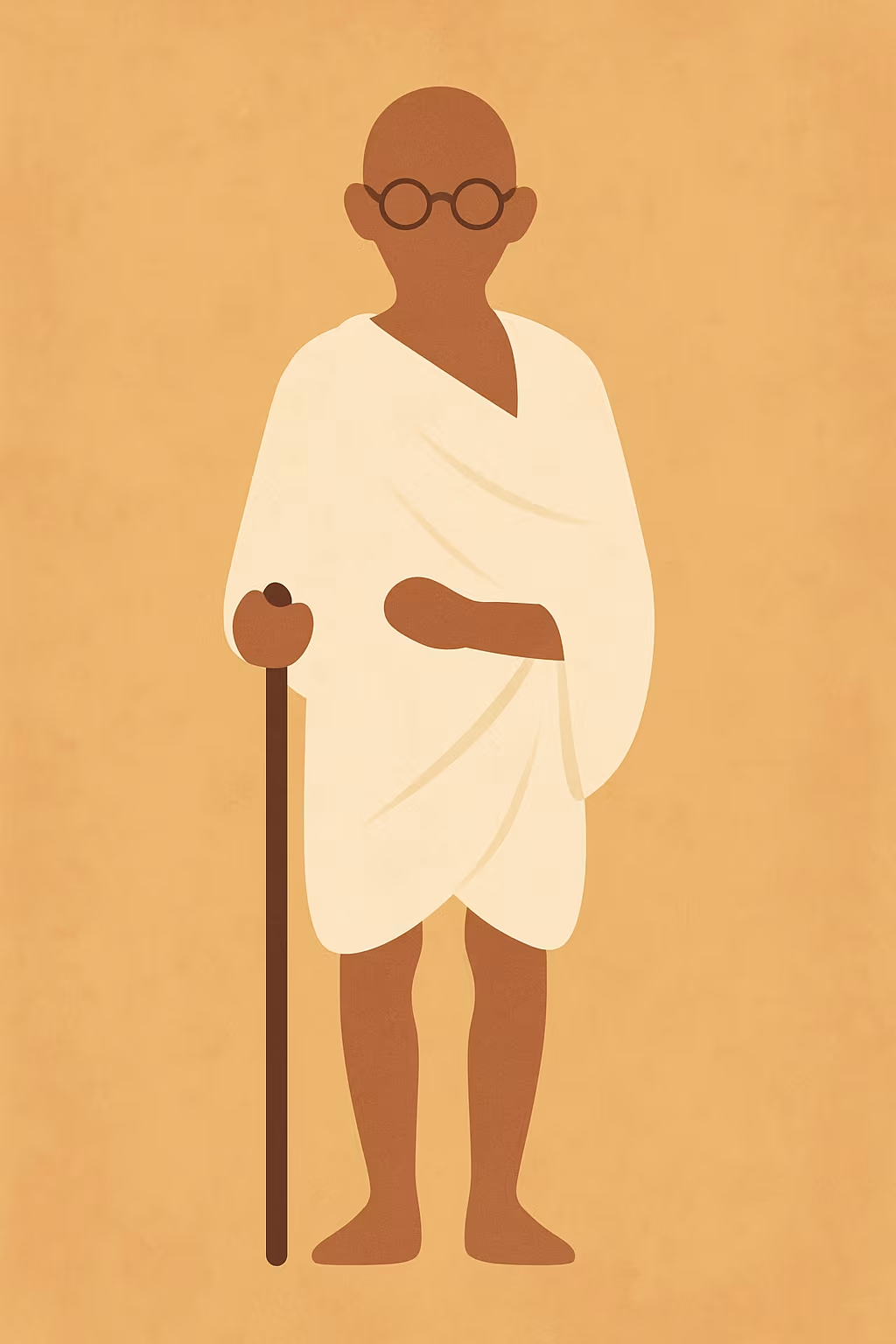Mahatma Gandhi (1869 – 1948)
Quick Summary
Mahatma Gandhi (1869 – 1948) was a lawyer and major figure in history. Born in Porbandar, Princely State of Kathiawar (British India, Gujarat), Mahatma Gandhi left a lasting impact through Formulated and applied satyagraha and ahimsa in mass politics.

Birth
October 2, 1869 Porbandar, Princely State of Kathiawar (British India, Gujarat)
Death
January 30, 1948 New Delhi, India
Nationality
Indian
Occupations
Complete Biography
Early Life
Mohandas Karamchand Gandhi was born on October 2, 1869, in Porbandar to a vaishya (bania) family; his father served as diwan of small princely states and his mother, Putlibai, was deeply devout. Raised within Hindu and Jain ethical traditions (vegetarianism, non-harm), he married Kasturba in 1883 and later left for England in 1888.
Education
In London (1888–1891), Gandhi studied law at the Inner Temple. He encountered modern vegetarianism, comparative religious literature, and debates on social ethics. Called to the bar in 1891, he struggled to establish a practice in India and accepted a legal assignment in South Africa in 1893.
South Africa
In South Africa (1893–1914), Gandhi experienced institutional racism and organized the Indian community, founding the Natal Indian Congress (1894). He established the Phoenix Settlement (1904) and Tolstoy Farm (1910). He formed volunteer ambulance corps during the Boer War and the 1906 Zulu campaign. From 1906, he developed satyagraha—nonviolent resistance—against discriminatory laws (Asiatic registration, immigration restrictions). He endured several imprisonments and secured partial concessions.
Return To India
Returning in 1915, Gandhi founded the Sabarmati Ashram at Ahmedabad and immersed himself in rural India. He led the Champaran indigo campaign (1917) and the Kheda tax relief struggle (1918). He rose within the Indian National Congress, popularizing khadi and economic boycotts alongside social reform (campaigns against ‘untouchability’, basic education).
Mass Movements
The Non-Cooperation movement (1920–1922) promoted boycotts of British institutions and goods; after the Chauri Chaura violence (1922), Gandhi suspended it and was imprisoned. He resumed civil disobedience with the 1930 Salt March to Dandi, challenged the salt tax monopoly, and attended the London Round Table Conference (1931). In 1932 he fasted against separate electorates for the ‘Depressed Classes’, leading to the Poona Pact with B. R. Ambedkar. Throughout the 1930s, he emphasized the constructive programme (local self-help, sanitation, education, cottage industries) and Hindu-Muslim unity. In 1942 he launched Quit India; Congress leaders were jailed until 1944.
Criticisms And Limits
Scholarly debates examine Gandhi’s early racial views in South Africa, his positions on caste and the pace of social reform, disagreements with Ambedkar over Dalit political representation, reservations about heavy industrialization, and the limits of nonviolence amid communal violence in 1946–1947. These debates coexist with recognition of his decisive role in mass mobilization and moral politics.
Assassination
After independence (August 1947) and Partition, Gandhi sought to quell violence through fasting and mediation in Calcutta and Delhi. On January 30, 1948, he was assassinated in New Delhi by Nathuram Vinayak Godse during a public prayer meeting.
Legacy
Gandhi’s blend of moral discipline, community organizing, and strategic noncooperation influenced civil rights and liberation movements worldwide (e.g., Martin Luther King Jr., Nelson Mandela). In India, his legacy is foundational yet continually debated in light of evolving social and political challenges.
Achievements and Legacy
Major Achievements
- Formulated and applied satyagraha and ahimsa in mass politics
- Led major campaigns: Champaran (1917), Kheda (1918), Non-Cooperation (1920–1922), Salt March (1930), Quit India (1942)
- Advanced social reform agendas against untouchability and for village industries
- Enduring global influence on nonviolent movements
Historical Legacy
Gandhi’s life helped recast politics as a moral enterprise tied to everyday discipline—spinning, fasting, service—while demonstrating how mass noncooperation could unsettle empire without arms. His repertoire remains a reference for civil resistance worldwide.
Detailed Timeline
Major Events
Birth
Porbandar, Kathiawar (British India)
South Africa
Begins legal work; organizes Indian community
Satyagraha
Launches nonviolent resistance in the Transvaal
Return to India
Founds Sabarmati Ashram
Champaran
Indigo farmers’ campaign
Salt March
240-mile march to Dandi
Quit India
Mass civil disobedience
Assassination
Killed in New Delhi
Geographic Timeline
Famous Quotes
“Non-violence is the greatest force at the disposal of mankind.”
“Freedom is not worth having if it does not include the freedom to make mistakes.”
Frequently Asked Questions
When was Gandhi born and when did he die?
Born October 2, 1869; assassinated January 30, 1948.
What do satyagraha and ahimsa mean?
Satyagraha is ‘truth-force’—insistence on truth through nonviolent pressure; ahimsa is the ethic of non-harm.
Which major campaigns did he lead?
Champaran (1917), Kheda (1918), Non-Cooperation (1920–1922), Salt March (1930), and Quit India (1942).
What social reforms did he advocate?
Abolition of untouchability, promotion of basic education and village industries, and religious pluralism.
How did he die?
He was assassinated in New Delhi during a public prayer meeting.
Sources and Bibliography
Primary Sources
- Collected Works of Mahatma Gandhi (CWMG), Publications Division, Government of India
- Young India (1920–1922) ; Harijan (1933–1948) – articles et éditoriaux de Gandhi
Secondary Sources
- Louis Fischer, The Life of Mahatma Gandhi ISBN: 9780060854935
- Judith M. Brown, Gandhi: Prisoner of Hope ISBN: 9780300051255
- Ramachandra Guha, Gandhi Before India ; Gandhi: The Years That Changed the World, 1914–1948
External References
See Also
Specialized Sites
Batailles de France
Discover battles related to this figure
Dynasties Legacy
Coming soonExplore royal and noble lineages
Timeline France
Coming soonVisualize events on the chronological timeline